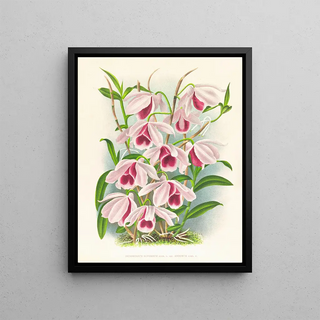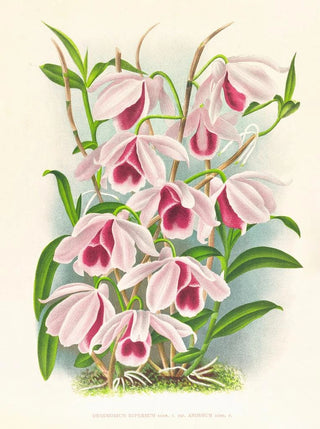Art print | Dendrobium superbum var. - Jean Jules Linden Source: Reproduction | Dendrobium superbum var. - Jean Jules Linden


View from behind

Frame (optional)
Dendrobium superbum var. - Jean Jules Linden art print takes us into the fascinating world of 19th-century botanical art. Jean Jules Linden, a Belgian botanist and painter, masterfully captures the delicate and ephemeral beauty of flowers in his works. This iconic piece, depicting a variety of orchid, invites us to explore the relationship between art and nature. Through his unique perspective, Linden offers not only a faithful representation of this plant but also an immersion into a world where every detail matters. The light, shadows, and vibrant colors blend to create an almost dreamlike atmosphere, perfect for contemplation and wonder.
Style and uniqueness of the work
Jean Jules Linden's style is distinguished by its botanical precision combined with rare artistic sensitivity. In Dendrobium superbum var., each petal, each leaf is rendered with meticulous care that reflects attentive observation and a deep respect for nature. The artist employs painting techniques that highlight the texture of the flowers, their brilliance, and fragility. The composition of the piece, while rigorous, exudes a certain lightness, as if the flowers are ready to take flight. This approach allows the viewer to feel not only the beauty of the orchid but also the artist's passion for the plant world. Linden's chosen color palette, oscillating between vivid hues and softer shades, reinforces this impression of life and dynamism.
The artist and his influence
Jean Jules Linden, born in 1817, is often regarded as one of the pioneers of modern botanical art. His work marked an era when the exploration of exotic plants was flourishing, and he played a crucial role in documenting these natural wonders. By combining his scientific knowledge with his artistic talent, Linden succeeded in evolving the representation of plants, making it accessible and appreciable to a broad audience. His influence is still felt today, not only in the field of botanical art but also in how we perceive and value nature. His works continue to inspire

Matte finish

View from behind

Frame (optional)
Dendrobium superbum var. - Jean Jules Linden art print takes us into the fascinating world of 19th-century botanical art. Jean Jules Linden, a Belgian botanist and painter, masterfully captures the delicate and ephemeral beauty of flowers in his works. This iconic piece, depicting a variety of orchid, invites us to explore the relationship between art and nature. Through his unique perspective, Linden offers not only a faithful representation of this plant but also an immersion into a world where every detail matters. The light, shadows, and vibrant colors blend to create an almost dreamlike atmosphere, perfect for contemplation and wonder.
Style and uniqueness of the work
Jean Jules Linden's style is distinguished by its botanical precision combined with rare artistic sensitivity. In Dendrobium superbum var., each petal, each leaf is rendered with meticulous care that reflects attentive observation and a deep respect for nature. The artist employs painting techniques that highlight the texture of the flowers, their brilliance, and fragility. The composition of the piece, while rigorous, exudes a certain lightness, as if the flowers are ready to take flight. This approach allows the viewer to feel not only the beauty of the orchid but also the artist's passion for the plant world. Linden's chosen color palette, oscillating between vivid hues and softer shades, reinforces this impression of life and dynamism.
The artist and his influence
Jean Jules Linden, born in 1817, is often regarded as one of the pioneers of modern botanical art. His work marked an era when the exploration of exotic plants was flourishing, and he played a crucial role in documenting these natural wonders. By combining his scientific knowledge with his artistic talent, Linden succeeded in evolving the representation of plants, making it accessible and appreciable to a broad audience. His influence is still felt today, not only in the field of botanical art but also in how we perceive and value nature. His works continue to inspire






